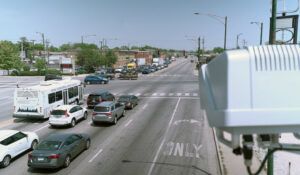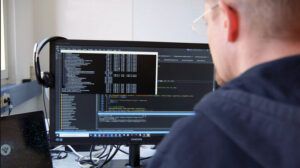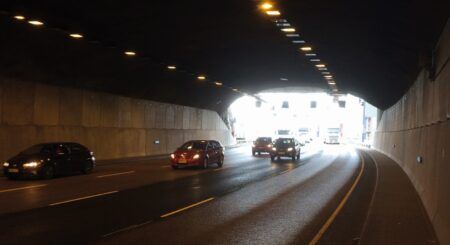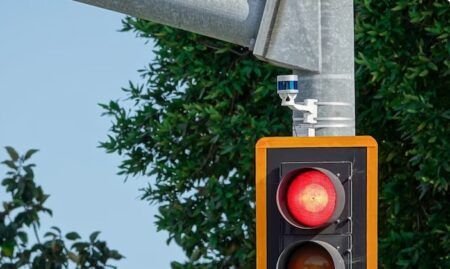Advances in AI and its use are a driver in almost every aspect of modern life, one might even say a game changer in many settings. And this is especially true in mobility, where AI is enabling new applications that support and fuel the traffic transition.
The vehicle for the performance of AI in traffic applications is easy access to more powerful hardware. This includes, on the one hand, faster, more compact, and performant processors, which increasingly enable more processing capacity in a small space, and, on the other hand, advanced camera technology, which has made a huge leap in recent years.
Industrial cameras today have more capabilities than the human eye – from colour recognition and a wide field of view to “seeing” very small details and vision in the infrared spectrum. Furthermore, they allow very good images to be taken even in poor visibility conditions, for example at night or in bad weather. With this hardware available, it is above all the software that determines the possibilities of the resulting video-based traffic enforcement. It decides what content can be processed, analysed, and utilized, in other words, how excellent vision is transferred into applications. Intelligent solutions are the key.
And what provides particularly promising approaches in this regard are neural networks such as CNNs (Convolutional Neural Networks), which are used at Vitronic. These networks can be trained with image material and deliver superior performance to algorithms for detection and identification. Straight to the point, they can capture objects more differentiated or more effective within milliseconds.
Road safety in view

To illustrate the benefits of AI for traffic, two areas can be looked at. The first is traffic safety or, more precisely, accident prevention. For example, intersections and junctions already account for nearly half of all road users injured or killed in urban settings. As a result of the traffic transition, road scenarios are becoming even more complex, especially at these traffic points, and increasingly diverse road users, including micromobility, are encountering each other. This further amplifies the risk of accidents.
Video-based enforcement systems using AI keep up with this change, as they allow the monitoring of more complex situations with various road users. They can, as a prime example, automatically distinguish between pedestrians, cyclists and motorized vehicles and thus detect when the right of way at crosswalks is not being complied with. This option significantly improves the safety of vulnerable road users (VRU). In addition, different violations can be captured simultaneously, which addresses several accident causers at once. Possible applications in traffic enforcement include the already highlighted surveillance of crosswalks, red light enforcement, documentation of turning violations and many more.
Mobile phone distraction

One innovation in this sector is a fully automated enforcement system using AI-based software that detects the use of a smartphone while driving. This is the answer to a very modern problem because this behaviour is widespread and extremely dangerous. Recent research shows that the risk of accidents increases twofold when talking on the phone, sixfold when texting, and twelvefold when typing a phone number. Many road users underestimate this risk, and since enforcement has been extremely costly in terms of manpower and virtually impossible to implement across the board, there has been little deterrent effect.
The new system changes this by its mobile as well as semi-stationary applicability and autonomous functionality. In this application, the AI is trained using images so that it recognizes when the driver of a vehicle is holding a mobile phone – replacing the time-consuming manual evaluation of image recordings. Therefore, the monitoring of mobile phone distractions is now possible anytime, anywhere and can change the behaviour of drivers in the medium and long term.
And the AI-based system has another application that contributes to road safety. It can be operated to detect seat belt violations. While this does not prevent accidents, it can significantly influence the severity of their outcome. A seat belt worn reduces the risk of fatal injury by at least 50%, and about one in four drivers or passengers killed in a traffic accident were not wearing a seatbelt or were not wearing it correctly. Soon, this AI-based system or similar ones could be deployed to capture even more distracted driving offenses and thus improve safety even further.
Advanced traffic management
The second area that highlights the progress AI brings to the table is the optimization of traffic in urban settings. Cities face the challenge of better managing traffic, making it more sustainable and reducing it. The following figures show how necessary this is. In 2022, drivers in major German cities spent an average of 40 hours stuck in traffic jams. And 96% of the urban population in the EU was exposed to air pollution levels higher than the WHO limits in 2020.
One way to make a difference here is through driveway regulations and restrictions. This involves, for example, low emission zones, lanes for public transport or high-occupancy vehicle lanes. Here, too, enforcement is often the challenge: How can we ensure that drivers do not use the bus lane? How can it be made sure that only authorized vehicles enter an environmental zone? Or even more difficult: how can it be detected that drivers are not traveling alone in a high-occupancy vehicle lane? Once again, AI provides a solution. Not only can it read license plates, but it is furthermore capable of capturing other information about a vehicle – from the type of automobile to the number of passengers. This creates a data basis that helps to implement effective measures.
A technology of the future

Looking at all this, it becomes clear why AI- and video-based traffic systems can be the facilitators of the traffic transition. But their application diversity and performance are not the only reasons. Two others are worth highlighting. First, their innovation potential. For developers, it is an affordable technology with lower entry barriers compared to others, which stimulates creative problem solving and further development. Second, the comparatively low investment they require for acquisition and implementation, coupled with the resulting faster ROI. This is particularly interesting for smaller municipalities, that previously had difficulties to refinance. Due to this new affordability of effective traffic systems more states and municipalities can utilize them, and in turn support a comprehensive realization of the traffic transition.
This article was first published in Intertraffic World 2024 magazine. To read the full issue, click here.





